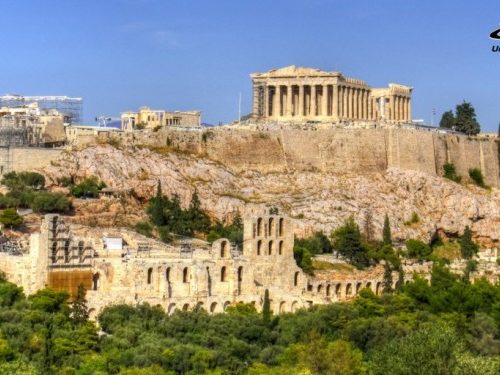Mount Aenos
Mount Aenos or is the tallest mountain in the Ioanian island ofCephallonia, Greece, with an elevation of 1,628 metres (5,341 ft).
Most of the mountain range is designated as a park area and is covered with Greek fir(Abies Cephalonica) and black pine (Pinus nigra). Pine forests are found between the elevations of 700 to 1200 m. On clear days, the view includes the NW Peloponnese and Aetolia along with theislands of Zakynthos, Lefkada, and Ithaca.
No ski resorts are found on this mountain range, but there are beautiful caves to be seen in the north. A highway passes over the mountain range connecting traffic from southwestern to the eastern part of the island is one of the few roads going into the mountain range. Approximately 3,000 to 4,000 people live on the slopes of Ainos. Multiple television and cell phone relay towers occupy the summit.
Alonnisos Marine
The National Marine Park of Alonnisos Northern Sporades was founded by Presidential Decree on May 16, 1992. It was the first of its kind in Greece, and is currently the largest marine protected area in Europe (approximately 2.260 km2). Besides the sea area, the park includes the island of Alonnisos, six smaller islands (Peristera, Kyra Panagia, Gioura, Psathoura, Piperi and Skantzoura), as well as 22 uninhabited islets and rocky outcrops. It is located in the region of the Northern Sporades Islands, in the northern Aegean Sea.
Mount Oeta
Mount Oeta older name: Katavothra is a mountain in southern Phthiotis and northern Phocis,Greece. A southeastern offshoot of the Pindus range, it forms the boundary between the valleys of the rivers Spercheios to the north, the Boeotian Cephissus to the southeast and the Mornos to the southwest. It is 2,152 m (7,060 ft) high. To its east is the mountain Kallidromo, which comes close to the sea, leaving only a narrow passage known as the famous pass of Thermopylae. There was also a high pass to the west of Kallidromo leading over into the upper Cephissus valley. The Oeta is southwest ofLamia, the nearest large town.
The national park, the lake, and the Mavrovo region are named after the village of Mavrovo.
Mount Olympus
Mount Olympus also transliterated as Olympos, and on Greek maps, Oros Olympos is the highest mountain in Greece, located in the Olympus Range on the border between Thessaly and Macedonia, about 80 km (50 mi) southwest from Thessaloniki, Greece’s second largest city. Mount Olympus has 52 peaks. The highest peak Mytikas, meaning “nose”, rises to 2,917 metres (9,570 ft). It is one of the highest peaks in Europe in terms of topographic prominence.
Mount Olympus is noted for its very rich flora with several species. It is a National Parkof Greece and a World’s Biosphere Reserve.
Mount Parnassuss
Mount Parnassus , is a mountain oflimestone in central Greece that towers above Delphi, north of the Gulf of Corinth, and offers scenic views of the surrounding olive groves and countryside. According to Greek mythology, this mountain was sacred to Apollo and the Corycian nymphs, and the home of the Muses. The mountain was also favored by the Dorians. There is a theory that Parna- derived from the same root as the word in Luwian meaning House.
Mount Parnitha
Mount Parnitha is a densely forested mountain range north of Athens, the highest on the peninsula of Attica, with an elevation of 1,413 m, and a summit known as Karavola . Much of the mountain is designated a national park, and is a protected habitat for wildfowl, first created in 1961. The summit is located 18 km N of Acharnae and about 30 km N of Athens, while the mountain covers approximately 250 km² of land. Other peaks include Mavrovouni Ornio (1,350 m), Area (1,160 m), Avgo or Avgho (1,150 m), and Xerovouni meaning dry mountain – 1,120 m).It also has two shelters Mpafi and Flampouri.
Pindus
Pindus National Park also known as Valia-Kalda, is a national park in mainland Greece, situated in an isolated mountainous area at the periphery of West Macedonia and Epirus, in the northeastern part of the Pindus mountain range. It was established in 1966 and covers an area of 6,927 hectares (17,120 acres). The park’s core zone, 3,360 hectares (8,300 acres), covers the greatest part of the Valia Kalda valley and the slopes of the surrounding peaks.
The National Park has an elevation range from 1,076 to 2,177 metres (3,530 to 7,142 ft) and is characterized by dense forests of European black pine and common beech, rocky ridges, several peaks over 2,000 metres (6,600 ft), rapid streams and mountain lakes. The area belong to the wider Pindus Mountains mixed forestsecoregion and is a representative part of Pindus mountain range. Moreover, it belongs to the Natura 2000 ecological network of protected areas and is one of the three places in Greece that hosts a population of bears.
Prespa
Prespa is the name of two freshwater lakes in southeast Europe, shared by Albania, Greece, and the Republic of Macedonia. Of the total surface area, 176.3 km2 (68.07 sq mi) belongs to the Republic of Macedonia, 46.3 km2 (17.88 sq mi) to Albania and 36.4 km2 (14.05 sq mi) to Greece. They are the highest tectonic lakes in the Balkans, standing at an altitude of 853 m (2,798 ft).
The Great Prespa Lake is divided between Albania, Greece and Macedonia. The Small Prespa Lake is shared only between Greece (138 km2 (53.28 sq mi) drainage area; 42.5 km2 (16.41 sq mi) surface area) and Albania (51 km2 (19.69 sq mi) drainage area; 4.3 km2 (1.66 sq mi) surface area).
Samariá Gorge
The Samariá Gorge is a National Park of Greece on the island of Crete – a major tourist attraction of the island – and a World’s Biosphere Reserve.
The gorge is in southwest Crete in the regional unit of Chania. It was created by a small river running between the White Mountains (Lefká Óri) and Mt. Volakias. There are a number of other gorges in the White Mountains. While some say that the gorge is 18 km long, this distance refers to the distance between the settlement of Omalos on the northern side of the plateau and the village of Agia Roumeli. In fact, the gorge is 16 km long, starting at an altitude of 1,250 m at the northern entrance, and ending at the shores of the Libyan Sea in Agia Roumeli. The walk through Samaria National Park is 13 km long, but one has to walk another three kilometers to Agia Roumeli from the park exit, making the hike 16 km long. The most famous part of the gorge is the stretch known as the Gates (or, albeit incorrectly, as “Iron Gates”), where the sides of the gorge close in to a width of only four meters and soar up to a height of almost 300 meters (1,000 feet). The gorge became a national park in 1962, particularly as a refuge for the rare kri-kri (Cretan goat), which is largely restricted to the park and an island just off the shore of Agia Marina. There are several other endemic species in the gorge and surrounding area, as well as many other species of flowers and birds.
The village of Samariá lies just inside the gorge. It was finally abandoned by the last remaining inhabitants in 1962 to make way for the park. The village and the gorge take their names from the village’s ancient church, Óssia María.
A must for visitors to Crete is to complete the walk down the gorge from the Omalos plateau to Agia Roumeli on the Libyan Sea, at which point tourists sail to the nearby village of Hora Sfakion and catch a coach back to Chania. The walk takes five to seven hours and can be strenuous, especially at the peak of summer.
Local tourist operators provide organized tours to the Gorge. These include bus transportation from one’s hotel to the entrance (near Omalos village), and a bus connection that will be waiting for hikers after they disembark the ferry in Sfakia (Chora Sfakion). If you are on your own, you can make a one-day round trip from Chania (see below) or from Sougia or Paleochora. Note that the morning buses from Sougia and Paleochora do not operate on Sunday. The ferries leave Agia Roumeli to Chora Sfakion (eastbound) and to Sougia/Paleochora (westbound) at 17:00.
Cape Sounion
Cape Sounion is a promontory located 69 kilometres (43 mi) SSE of Athens, at the southernmost tip of the Attica peninsula in Greece. Cape Sounion is noted as the site of ruins of an ancient Greek temple of Poseidon, the god of the sea in classical mythology. The remains are perched on the headland, surrounded on three sides by the sea. The ruins bear the deeply engraved name of English Romantic poet Lord Byron(1788–1824).
The site is a popular day-excursion for tourists from Athens, with sunset over the Aegean Sea, as viewed from the ruins, a sought-after spectacle.
Vikos–Aoös
The Vikos–Aoös National Park is a national park in the region of Epirus in northwestern Greece. The park, founded in 1973, is one of ten national parks in mainland Greece and is located 30 kilometres (19 mi) north of the city of Ioannina in the northern part of the Pindus mountain range. It is named after the two major gorges of the area and encompasses 12,600 hectares (31,135 acres) of mountainous terrain, with numerous rivers, lakes, caves, deep canyons, dense coniferous anddeciduous forest. The park is part of the Natura 2000 ecological network and one of UNESCO Geoparks and spans an elevation range from 550 to 2,497 meters (1,800 to 8,192 ft).[1] Over 100,000 people visit the park each year and take part in activities including rafting, canoe-kayaking, hiking and mountain biking.
The core of the park, an area of 3,400 hectares (8,402 acres), comprises the spectacular Vikos Gorge, carved by the Voidomatis river. The gorge’s main part is 12 km (7 mi) long and attains a depth of 1,000 meters (3,300 ft). The Aoös gorge, mount Tymfi (2,497 meters (8,192 ft) at Gamila peak), and a number of traditionally preserved settlements form the park’s peripheral zone. The park’s remoteness and relatively small human population, combined with the great variation of biotopesand microclimatic conditions favors the existence of a rich variety of flora (1,800 species) in the area. Vikos–Aoös National Park supports a wide diversity of fauna, with a plethora of large mammals such as the brown bear, for which the park is one of the last European strongholds, and a variety of natural habitats and ecosystems that rank it among the most valuable parks for nature conservation in Greece.
The first evidence of human presence in the area is dated between 17,000 and 10,000 years ago. The area of the park has been sparsely populated throughout historical times, however from the 17th to the 19th century the local communities of Zagori acquired an autonomous status, flourished economically due to increased trade, and became a major center of folk medicine. In recent decades,ecotourism is seen as a remedy to the economic decline of heavily depopulated local settlements, while preserving the natural environment and local architecture.
Zakynthos
The National Marine Park of Zakynthos founded in 1999, is a national park located in Laganas bay, in Zakynthosisland, Greece. The park, part of the Natura 2000 ecological network, covers an area of 135 square kilometres (52 sq mi) and is the habitat of the Loggerhead Sea Turtle (Caretta caretta). It is the first national park established for the protection of sea turtles in the Mediterranean.





